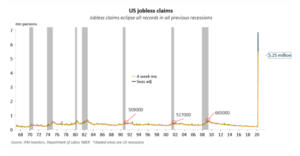The good news is that all our good work in trying to reduce new cases of Coronavirus is working… and impressively so. The disruption to our lives is really paying dividends.
When you look at the tragic death rates in the US and UK, you realise how lucky we are to be here in Australia. And, hopefully, a lot of the restrictions will be eased over the next month if we can maintain the current performance.
So it appears we’re getting the health crisis under control.
But the financial and economic crisis is just starting to bite and may last for many months.
This week the International Monetary Fund came out with a pretty sobering forecast on the Australian economy.
The IMF noted that the Federal Government’s stimulus response has been “swift and sizable”. After the economy growing by 1.8 per cent in 2019, the IMF forecasts a 6.7 per cent contraction in the economy in calendar 2020 and 6.1 per cent expansion in 2021. Unemployment is expected to average 7.6 per cent in 2020 and 8.9 per cent in 2021.
If realised, the projected downturn of the global economy would be more significant than the global financial crisis (GFC). In 2008 the world economy grew by 3 per cent, before contracting 0.1 per cent in 2009 and then lifting 5.4 per cent in 2010 and growing 4.3 per cent in 2011.
If the IMF forecasts are realised the global economy would experience the biggest contraction since the end of World War 2. And outside the war periods, the decline would be the most significant since the Great Depression (1929-1932).
The Australian economy didn’t go through a recession in the GFC, it actually grew by 1.9 per cent in 2009.
The IMF expects a bigger downturn in the Australian economy than many other nations, but unemployment isn’t tipped to rise as high as it did in the 1983 recession and the 1991-1994 period when unemployment averaged 10.2 per cent. Arguably Australia has more potential at a ‘V-shaped’ recovery given the extent of the economic stimulus.
But the IMF expects the Chinese economy to lift 9.2 per cent in 2021. If this forecast is right you could argue its forecasts for Australia will be a bit too pessimistic.
The jobs calm before the storm
Don’t be fooled by the latest jobs figures for March which showed the creation of 5900 new positions… it covered the March 1-14 two week period. That was just before Australia closed its borders and went into lockdown.
Doesn’t seem that long ago does it… but so much has happened since then. The world has been thrown into chaos.
Yes the unemployment rate rose to 5.2 per cent but, unfortunately, this is just the start. Most economists are predicting our unemployment will rise to 10-12 per cent over the next couple of months.
America is providing a scary insight into the future of unemployment
Over the last couple of weeks I’ve been following the number of Americans who have registered for unemployment. Last week it was 5.25 million, the week before that 3 million, 2 million the week before that… 10 million in 3 weeks.
The numbers are absolutely devastating. Some economists think US unemployment will get to 17-20 per cent. The resulting financial distress and social disruption will be enormous…in a society with so many guns.
To put it into perspective have a look at this graph. The yellow line records the highest weekly unemployment registrations during each of America’s last 8 economic recessions… and how last week’s 5.25 million compares.
As you can see it is off the charts crazy. It really is tragic and the main reason why President Trump is so desperate to get Americans working again.


Where are the dividends going to be paid
Sharemarkets are awash with tidal wave of announcements… earnings downgrades, withdrawal of profit guidance, capital raisings and whether dividends can be maintained.
It is certainly a volatile time.
For a lot of investors (particularly self funded retirees) it’s the prospect of having dividends cut which is causing the most concern. So far 38 companies in the ASX 200 have either suspended, deferred or cut their dividends…. And another 60 have dividend per share forecasts fall.
Many investors are overweight the big 4 banks in the portfolio because of their dividend payout which are now seriously under threat.
So it’s timely that investment bank UBS have come out with a list of stocks which they believe have the best prospects for investors and pay a good dividend.
UBS have selected Aurizon, Ausnet Metcash, Coles Group, APA Group and Woolworths as being the best bets.
Honourable mentions are given to AGL Energy, Amcor, Brambles, Bunnings landlord BWP Trust, CSL, Inghams, Kogan, Magellan, ResMed Rural Funds, Wesfarmers, Telstra and Clover Corporation as providing reliable earnings streams to support dividends.
The UBS report also shines a light on SkyCity, Sydney Airport, JB Hi-Fi, Scentre Group, Challenger and Vicinity Centres as companies which have dividend payout expectations that are too high and may not deliver.




























Trending